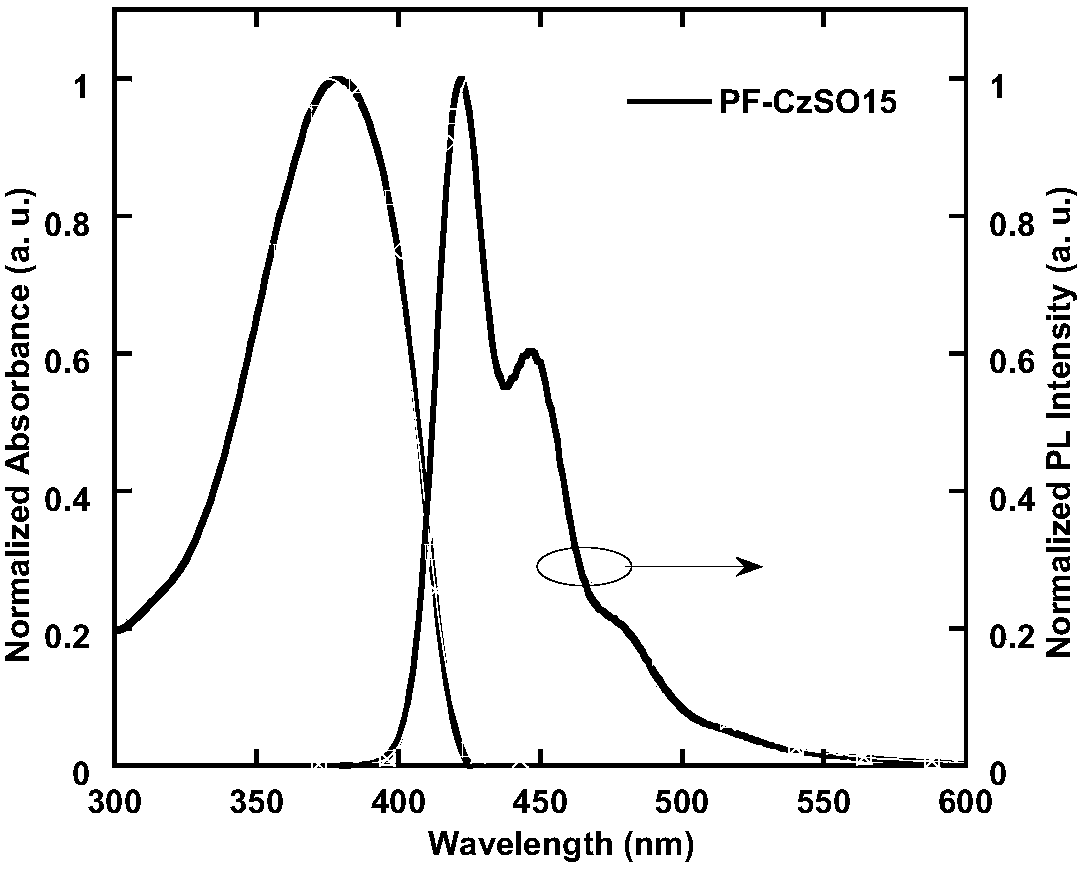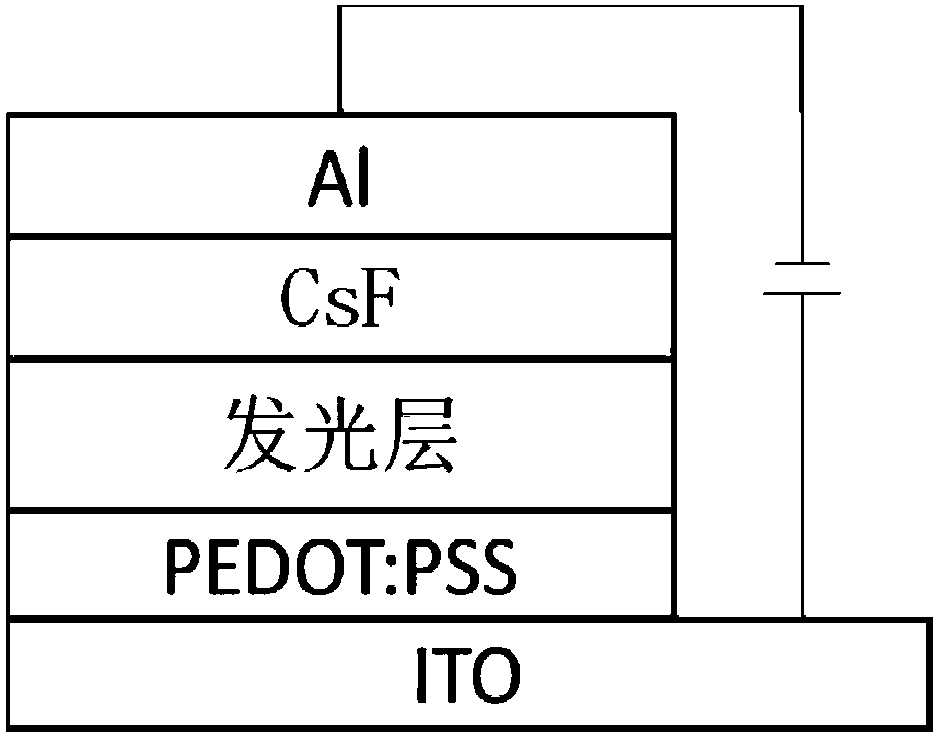A kind of monolayer exciplex and monomolecular exciplex white light polymer and its preparation method and application
An exciplex, single-layer technology, applied in chemical instruments and methods, luminescent materials, semiconductor/solid-state device manufacturing, etc., can solve problems such as complex manufacturing processes, and achieve simple manufacturing processes, low manufacturing costs, and good spectra. The effect of controllability and device stability
- Summary
- Abstract
- Description
- Claims
- Application Information
AI Technical Summary
Problems solved by technology
Method used
Image
Examples
Embodiment 1
[0058] Embodiment 1: the preparation of polymer PF-T25
[0059] Under argon protection, 2,7-bis(4,4,5,5-tetramethyl-1,3,2-dioxaborolin-2-yl)-9,9- Bis(4-(2-ethylhexyloxy)phenyl)fluorene (413.5mg, 0.5mmol), 2,7-dibromo-9,9-bis(4-(2-ethylhexyloxy) ) phenyl) fluorene (183.2mg, 0.25mmol), TPA (325.3mg, 0.25mmol), and palladium acetate (3.4mg, 0.015mmol) and tricyclohexyl phosphorus (8.4mg, 0.03mmol), after sealing the instrument, inject Stir 15mL of toluene until completely dissolved, heat up to 80°C, and then add 20wt% organic base tetrabutylhydroxylamine solution (2mL). Under the protection of argon, the reaction temperature was kept at 80°C. After 24 hours of reaction, 15 mg of 2,7-bis(4,4,5,5-tetramethyl-1,3,2-dioxyborate -2-yl)-9,9-bis(4-(2-ethylhexyloxy)phenyl)fluorene, 1 mg of palladium acetate and 2 mg of tricyclohexylphosphine were dissolved in 3 mL of toluene and capped at 80 °C reaction temperature, after continuing the reaction for 12 hours, 0.5 mL of bromobenzene wa...
Embodiment 2
[0061] Embodiment 2: the preparation of polymer PF-OXD20
[0062] Under argon protection, 2,7-bis(4,4,5,5-tetramethyl-1,3,2-dioxyboronate-2 base)-9,9- Dioctylfluorene (642.6mg, 1.0mmol), 2,7-dibromo-9,9-dioctylfluorene (329.0mg, 0.6mmol), 2,7-dibromo-9,9-bis(4- (5-(4-tert-butylphenyl)-2-oxadiazole)phenoxy)fluorene (424.4mg, 0.4mmol) and palladium acetate (6.8mg, 0.03mmol) and tricyclohexylphosphine (16.8mg, 0.06mmol), after sealing the instrument, inject 20mL of toluene and stir until completely dissolved, heat up to 80°C, and then add 20wt% organic base tetrabutylhydroxylamine solution (5mL). Under the protection of argon, the reaction temperature was kept at 80°C. After 24 hours of reaction, 25 mg of 2,7-bis(4,4,5,5-tetramethyl-1,3,2-dioxyborate -2-yl)-9,9-bis(4-(2-ethylhexyloxy)phenyl)fluorene, 2 mg of palladium acetate and 4 mg of tricyclohexylphosphine were dissolved in 5 mL of toluene and capped at 80 °C reaction temperature, after continuing the reaction for 12 hours...
Embodiment 3
[0064] Embodiment 3: the preparation of polymer PFSO-OXD10
[0065] Under argon protection, 2,7-bis(4,4,5,5-tetramethyl-1,3,2-dioxyboronate-2 base)-9,9- Dioctylfluorene (642.6mg, 1.0mmol), 2,7-dibromo-9,9-dioctylfluorene (329.0mg, 0.6mmol), 2,7-dibromo-9,9-bis(4- (5-(4-tert-butylphenyl)-2-oxadiazole)phenoxy)fluorene (212.2mg, 0.2mmol), 3,7-dibromo-dibenzothiophene-S,S-dioxy (74.8mg, 0.2mmol), palladium acetate (6.8mg, 0.03mmol) and tricyclohexylphosphine (16.8mg, 0.06mmol), after sealing the instrument, inject 20mL of toluene and stir until completely dissolved, heat up to 80°C, and then add 20 wt% solution of organic base tetrabutylhydroxylamine (5 mL). Under the protection of argon, the reaction temperature was kept at 80°C. After 24 hours of reaction, 25 mg of 2,7-bis(4,4,5,5-tetramethyl-1,3,2-dioxyborate -2-yl)-9,9-bis(4-(2-ethylhexyloxy)phenyl)fluorene, 2 mg of palladium acetate and 4 mg of tricyclohexylphosphine were dissolved in 5 mL of toluene and capped at 80 °C r...
PUM
| Property | Measurement | Unit |
|---|---|---|
| current efficiency | aaaaa | aaaaa |
| luminance | aaaaa | aaaaa |
Abstract
Description
Claims
Application Information
 Login to View More
Login to View More - R&D
- Intellectual Property
- Life Sciences
- Materials
- Tech Scout
- Unparalleled Data Quality
- Higher Quality Content
- 60% Fewer Hallucinations
Browse by: Latest US Patents, China's latest patents, Technical Efficacy Thesaurus, Application Domain, Technology Topic, Popular Technical Reports.
© 2025 PatSnap. All rights reserved.Legal|Privacy policy|Modern Slavery Act Transparency Statement|Sitemap|About US| Contact US: help@patsnap.com



